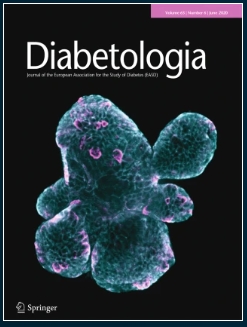全球原住民青少年2型糖尿病患病率:系统回顾
IF 10.2
1区 医学
Q1 ENDOCRINOLOGY & METABOLISM
引用次数: 0
摘要
目的/假设我们旨在综合25岁以下土著青年2型糖尿病的全球患病率估计,并检查年龄和性别特异性差异和长期趋势。方法检索1980年1月1日至2024年9月14日的MEDLINE、Embase、CINAHL和Cochrane,以及纳入研究的文献。我们纳入了横断面观察性研究,报告了所有地区25岁以下土著青年的糖尿病点患病率估计(每1000人)和患病率趋势。报告了具体年龄和性别的分析和长期趋势。采用适用于土著健康研究的改良纽卡斯尔-渥太华量表评估研究质量。结果从2342条记录和27篇附加文献中,保留49篇研究进行数据提取。来自6个国家和两个自治州的36个不同人群的49项研究中,有33项研究报告了2型糖尿病的总患病率,差异很大(每1000人中0-44人),75%(27/36)的人群报告的患病率超过每1000人中1人。44项研究提供的年龄特异性数据显示,年龄越大患病率越高:<10岁时每1000人中0-4人;10-19岁儿童每千人0-44人;在15-25岁的人群中,每1000人中有0-64人。在22项有特定性别数据的研究中,77%显示女性占优势。自1981年以来的12项研究显示,10项研究中有8项显示年轻人(15-25岁)的患病率在上升,9项研究中有6项显示15岁以下青少年的患病率在上升。研究设计、诊断标准的异质性以及年龄和性别分类的不完全排除了meta分析的可能性。结论/解释青年2型糖尿病在土著人群中的患病率非常高,特别是在青年成年期和女性中。患病率随着时间的推移而增加。未来的研究应按年龄和青春期状态对数据进行分层,并确定保护因素和危险因素,为有针对性的预防策略提供信息。土著主导的、针对社区的方法,积极吸引青年参与,对于糖尿病监测、预防和管理规划的制定和实施至关重要。试用注册号普洛斯彼罗注册号CRD42021278418。本文章由计算机程序翻译,如有差异,请以英文原文为准。
Prevalence of youth type 2 diabetes in global Indigenous populations: a systematic review.
AIMS/HYPOTHESIS
We aimed to synthesise global prevalence estimates of type 2 diabetes among Indigenous youth aged under 25 years, and examine age- and gender-specific differences and secular trends.
METHODS
We searched MEDLINE, Embase, CINAHL and Cochrane, and bibliographies of included studies, from 1 January 1980 to 14 September 2024. We included cross-sectional observational studies that reported diabetes point prevalence estimates (per 1000) and prevalence trends in Indigenous youth aged under 25 years from all regions. Age- and gender-specific analysis and secular trends were reported. Study quality was assessed using a modified Newcastle-Ottawa Scale adapted for Indigenous health research.
RESULTS
From 2342 records and 27 additional references, 49 studies were retained for data extraction. Total type 2 diabetes prevalence, reported in 33 of 49 studies from 36 distinct populations across six countries and two self-governing states, varied widely (0-44 per 1000), with 75% (27/36) of the populations reporting a prevalence of over 1 per 1000. Age-specific data, available in 44 studies, showed increased prevalence with age: 0-4 per 1000 at age <10 years; 0-44 per 1000 at age 10-19 years; and 0-64 per 1000 at age 15-25 years. Of 22 studies with gender-specific data, 77% showed a female predominance. Secular trends, examined in 12 studies since 1981, showed a rising prevalence in young adults (aged 15-25 years) in eight of ten studies, and in youth aged under 15 years in six of nine studies. Heterogeneity in study design, diagnostic criteria, and incomplete age- and gender disaggregation precluded meta-analysis.
CONCLUSIONS/INTERPRETATION
Youth type 2 diabetes prevalence in Indigenous populations is very high, particularly in young adulthood, and among the female sex. Prevalence has increased over time. Future research should stratify data by age and pubertal status, and identify both protective and risk factors to inform targeted prevention strategies. Indigenous-led, community-specific approaches that actively engage youth are critical in the development and implementation of diabetes surveillance, prevention and management programmes.
TRIAL REGISTRATION
PROSPERO registration no. CRD42021278418.
求助全文
通过发布文献求助,成功后即可免费获取论文全文。
去求助
来源期刊

Diabetologia
医学-内分泌学与代谢
CiteScore
18.10
自引率
2.40%
发文量
193
审稿时长
1 months
期刊介绍:
Diabetologia, the authoritative journal dedicated to diabetes research, holds high visibility through society membership, libraries, and social media. As the official journal of the European Association for the Study of Diabetes, it is ranked in the top quartile of the 2019 JCR Impact Factors in the Endocrinology & Metabolism category. The journal boasts dedicated and expert editorial teams committed to supporting authors throughout the peer review process.
 求助内容:
求助内容: 应助结果提醒方式:
应助结果提醒方式:


